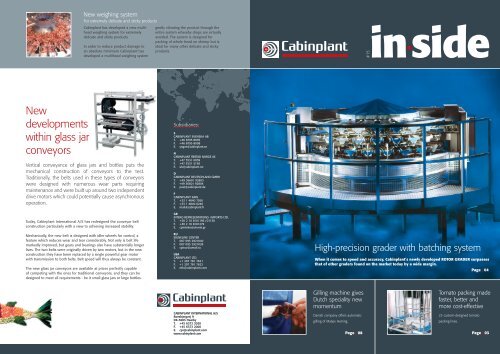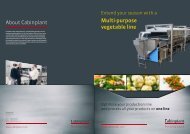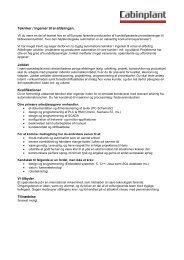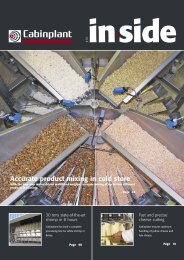facts - Cabinplant international
facts - Cabinplant international
facts - Cabinplant international
You also want an ePaper? Increase the reach of your titles
YUMPU automatically turns print PDFs into web optimized ePapers that Google loves.
New<br />
developments<br />
with in glass jar<br />
conveyors<br />
New weighing system<br />
For extremely delicate and sticky products<br />
<strong>Cabinplant</strong> has developed a new multihead<br />
weighing system for extremely<br />
delicate and sticky products<br />
In order to reduce product damage to<br />
an absolute minimum <strong>Cabinplant</strong> has<br />
developed a multihead weighing system<br />
Vertical conveyance of glass jars and bottles puts the<br />
mechanical construction of conveyors to the test.<br />
Traditionally, the belts used in these types of conveyors<br />
were designed with numerous wear parts requiring<br />
maintenance and were built up around two independent<br />
drive motors which could potentially cause asyn chronous<br />
operation.<br />
Today, <strong>Cabinplant</strong> International A/S has redesigned the conveyor belt<br />
construction particularly with a view to achiev ing increased stability.<br />
Mechanically, the new belt is designed with idler wheels for control, a<br />
feature which reduces wear and tear considerably. Not only is belt life<br />
markedly improved, but gears and bearings also have substantially longer<br />
lives. The two belts were originally driven by two motors, but in the new<br />
construction they have been replaced by a single powerful gear motor<br />
with transmission to both belts. Belt speed will thus always be constant.<br />
The new glass jar conveyors are available at prices per fectly capable<br />
of competing with the ones for traditional conveyors, and they can be<br />
designed to meet all requirements - be it small glass jars or large bottles.<br />
gently vibrating the product through the<br />
entire system whereby drops are virtually<br />
avoided. The system is designed for<br />
packing of whole head on shrimp but is<br />
ideal for many other delicate and sticky<br />
products.<br />
Subsidiaries:<br />
S<br />
CABINPLANT SVENSKA AB<br />
T. +46 8795 8095<br />
F. +46 8795 8008<br />
E. yngve@cabinplant.se<br />
N<br />
CABINPLANT ÅRSTAD NORGE AS<br />
T. +47 5531 0059<br />
F. +47 5531 5158<br />
E. ub@cabinplant.no<br />
D<br />
CABINPLANT DEUTSCHLAND GMBH<br />
T. +49 36601 92803<br />
F. +49 36601 92804<br />
E. post@cabinplant.de<br />
F<br />
CABINPLANT SARL<br />
T. +33 1 4840 7050<br />
F. +33 1 4840 0246<br />
E. mail@cabinplant.fr<br />
GR<br />
INTEKO REPRESENTATIONS . IMPORTS LTD.<br />
T. +30 2 10 8101196 / 01130<br />
F. +30 2 10 8101279<br />
E. cpinteko@otenet.gr<br />
RU<br />
EIGNELINE CENTER<br />
T. 007 095 2921040<br />
F. 007 095 2921028<br />
E. cpiruv@umail.ru<br />
USA<br />
CABINPLANT LTD.<br />
T. +1 207 781 7621<br />
F. +1 207 781 7622<br />
E. nth@cabinplant.com<br />
CABINPLANT INTERNATIONAL INTERNATIONAL A/S<br />
Roesbjergvej Roesbjergvej 9<br />
DK-5683 Haarby<br />
T. +45 6373 2020<br />
F. +45 6373 2000 2000<br />
E. cpi@cabinplant.com<br />
www.cabinplant.com<br />
www.cabinplant.com<br />
Gilling machine gives<br />
Dutch speciality new<br />
momentum<br />
Danish company offers automatic<br />
gilling of Matjes Herring.<br />
Page | 08<br />
#15<br />
High-precision grader with batching system<br />
When it comes to speed and accuracy, <strong>Cabinplant</strong>’s newly developed ROTOR GRADER surpasses<br />
that of other graders found on the market today by a wide margin.<br />
Page | 04<br />
Tomato packing made<br />
faster, better and<br />
more cost-effective<br />
23 custom-designed tomato<br />
packing lines.<br />
Page | 03
Contents<br />
Tomato packing made faster,<br />
better and more cost-effective . . . . . page 03<br />
High-precision grader with<br />
batching system . . . . . . . . . . . . . . . . . . . page 04<br />
Modern cannery in Mauritius . . . . . . page 06<br />
Gilling machine gives Dutch<br />
speciality new momentum . . . . . . . . . page 08<br />
Double the capacity for half<br />
the investment . . . . . . . . . . . . . . . . . . . . page 09<br />
State-of-the-art spring roll<br />
machines . . . . . . . . . . . . . . . . . . . . . . . . . . page 10<br />
New developments within<br />
glass jar conveyors . . . . . . . . . . . . . . . . page 12<br />
It is <strong>Cabinplant</strong>’s declared goal to strengthen our position on the global market. One of the means for achieving this will be to<br />
increase our focus on the <strong>international</strong> exhibitions. For the year 2004 <strong>Cabinplant</strong> will dedicate the major part of its resources<br />
to the Boston Seafood Exposition, IPA in Paris and the Seafood Processing Europe in Brussels. We look forward to meeting you.<br />
EXHIBITIONS<br />
Year Name Country City Date Stand<br />
2004 Seafood Processing Europe Belgium Brussels 4.- 6. May 5211<br />
Norfishing Norway Trondheim 10. - 13. Aug.<br />
World Food Moscow Russia Moscow 21. - 24. Sep.<br />
IPA France Paris 22. - 26. Nov.<br />
2005 Boston Seafood Show USA Boston 13. - 15. Mar.<br />
Interpack Germany Düsseldorf 21. - 27. Apr.<br />
Foodtech Denmark Herning 15. - 17. Nov.<br />
2006 Scanpack Sweden Gothenburg 24. - 27. Oct.<br />
<strong>Cabinplant</strong> News is published by <strong>Cabinplant</strong> International A/S, Denmark, Distribution: <strong>Cabinplant</strong> customers, agents, subsidiaries, co-operation partners, etc.<br />
Editors: Lars Kops and Pernille Bæk, Languages: English, German, French and Russian, Graphics and layout: Cosmographic A/S<br />
:: A specially designed distribution tool is<br />
used to put the tomatoes into the clamshells.<br />
Tomato packing made faster,<br />
better and more cost-effective<br />
23 custom-designed tomato packing lines<br />
In close co-operation with one of the largest producers of<br />
sweet cherry tomatoes <strong>Cabinplant</strong> has developed a new<br />
line for weighing and packing of tomatoes in clamshell<br />
trays. So far, a number of lines have been supplied and<br />
they have performed so well that more lines are presently<br />
being installed in the produ cer’s other packing facilities.<br />
The customer wanted to increase efficiency and yield, a<br />
goal which <strong>Cabinplant</strong> has more than fulfilled. Previously,<br />
fifteen employees were required to operate each packing<br />
line with a maximum capacity of 70 clamshells per<br />
minute. The new <strong>Cabinplant</strong> line with four employees<br />
can handle up to 120 clamshells (of the 280 g version)<br />
per minute and at the same time increase accuracy, yield<br />
and versatility.<br />
Despite the high packing line speed, accuracy is very<br />
high with the <strong>Cabinplant</strong> multihead weigher ensuring<br />
a neg ligible weight deviation of ±3 g. This minor<br />
tolerance combined with a small negative acceptance<br />
mean packing at nominal weight during a day’s<br />
production i.e. NO GIVE AWAY – a feature which<br />
increases line yield significantly.<br />
Being capable of handling four different clamshell<br />
sizes ranging from 280 to 908 g, the fully automatic<br />
<strong>Cabinplant</strong> weighing and packing line also features a<br />
higher degree of versatility than previously available in<br />
the market.<br />
The large order is yet another demonstration of<br />
<strong>Cabinplant</strong>’s ability to analyse, design, build and<br />
exceed customer requirements. This customer also<br />
attached great importance to <strong>Cabinplant</strong>’s ability to<br />
supply complete, integra ted systems and as such<br />
<strong>Cabinplant</strong> supp lied everything from step conveyor,<br />
clamshell dispensers, infeed system, multihead weigher,<br />
filling station to lid sealer and labelling. <strong>Cabinplant</strong> also<br />
provides the in-plant training of customer’s staff enabling<br />
them to operate and service the lines at local plant level.<br />
:: Change of packing material is done<br />
without the use of tools.<br />
CABINPLANT INSIDE 03
High-precision grader<br />
with batching system<br />
When it comes to speed and accuracy, <strong>Cabinplant</strong>’s newly developed ROTOR GRADER surpasses<br />
that of other graders found on the market today by a wide margin. Using its agelong experience<br />
within the manufacture of multihead weighers, <strong>Cabinplant</strong> has succeeded in developing a grader<br />
offering a second-to-none precision and speed.<br />
Until now, the electronic weight grading market has been<br />
dominated by dynamic weighing systems (items are<br />
weighed while moving). The obvious drawback of these<br />
systems is that weighing accuracy falls drastically with<br />
increasing speed because of vibrations, short weighing<br />
time, uneven distance between items, air resistance, etc.<br />
The items also have to be shaped in such a way that<br />
they remain on the belt during weighing.<br />
As <strong>Cabinplant</strong>’s ROTOR GRADER weighs items statically<br />
(no movoment during weighing), the result is an<br />
unparalleled accuracy, which is more or less independent<br />
of speed and the shape of the items.<br />
Being capable of weighing nine items at a time – as<br />
opposed to the dynamic grader, which can only weigh<br />
one item at a time – the ROTOR GRADER ensures a<br />
markedly higher capacity, i.e. 300 items per minute.<br />
The ROTOR GRADER is available either as a grader or a<br />
combined grading/batching version.<br />
The number of grades is freely programmable up to 12,<br />
and there is an extra receptacle for items not complying<br />
with the set weight limits.<br />
In the batching version items are accumulated in a<br />
receptacle until the required batch weight is achieved,<br />
and the portion is then dumped into another container.<br />
The grader is programmed using an extremely userfriendly<br />
touch display from where it is also possible to<br />
print all weighing and processing data.<br />
TECHNICAL SPECIFICATION<br />
(preliminary)<br />
Capacity: Up to 300 items/min.<br />
Weighing range: 5-500 g or 10-1000 g<br />
Accuracy: +/- 0.1 g<br />
No. of grades: Up to 12 +1<br />
No. of operators: 3<br />
CABINPLANT INSIDE 05
CABINPLANT INSIDE 06<br />
Modern cannery<br />
in Mauritius<br />
One of the most modern tuna processing factories in the world is in Mauritius. The plant com prises<br />
a combined thawing, cooking and cooling system. The patented system has been designated as<br />
an ITCC – Integrated Thawing, Cooking and evaporative Cooling System.<br />
The Princes Foods factory incorporating <strong>Cabinplant</strong>’s<br />
system is brand new. It replaces a factory that was more<br />
than 100 years old and which had to be closed down<br />
because of new EU hygiene standards. Princes Foods,<br />
owned by the Japanese company Mitsubishi, decided<br />
to retain the factory’s location on the island; this made<br />
good sense in terms of raw material logistics and the<br />
numerous jobs at stake.<br />
The new system is very different from the systems used<br />
by other, similar factories. Elsewhere, for example, the<br />
frozen tuna are placed in large tanks to thaw in running<br />
water; this method often results in fish temperature<br />
differences and a very high water consumption.<br />
At Princes Foods, the frozen tuna are transported into<br />
a number of <strong>Cabinplant</strong> chambers, and the process<br />
of thawing, cooking and cooling takes place in one<br />
operation. Prior to installation of the new system, the tuna<br />
thawing, cooking and cooling process took considerably<br />
longer time; whereas now the process has been reduced<br />
to 5 1 /2 hours for fish of approx. 2.5 to 3.0 kg.<br />
A computer controlling the system ensures that the<br />
minimum amount of water is used. At the old factory,<br />
1,800 m 3 of water were required to process and prepare<br />
80 tn. of tuna. With the new system, the factory only uses<br />
600 m 3 of water for 190 tn. That is an important factor,<br />
as water is an expensive commodity in Mauritius.<br />
The goal for the new system was to attain a production<br />
of 150 tn. of tuna per day within three years, but that<br />
goal was reached within a merely 21 days following<br />
a few minor adjustments to the system. The factory<br />
employs 2,000 persons and currently produces between<br />
220 and 230 tn. per day.<br />
Princes Foods has invested heavily in laboratory<br />
equipment and staff to ensure that every hygiene<br />
standard is met. The whole system is constructed of<br />
stainless steel to reduce maintenance and optimise<br />
hygiene. Thanks to this high level of quality, Princes<br />
Foods is currently the supplier of canned tuna to major<br />
supermarket chains in the UK.<br />
A total of 190 containers full of canned tuna leave the<br />
factory each month, to be sold mainly in Europe.<br />
FACTS<br />
The advantages of thawing, cooking and<br />
cooling in one machine are:<br />
■ High capacity with maximum yield<br />
■ Reduced water consumption<br />
■ Reduced waste water<br />
■ Less manpower<br />
■ Easy cleaning – CIP<br />
■ Data collection of process parameters<br />
Frozen tuna<br />
Frozen tuna are packed in the steel baskets<br />
and put in the trolleys. The filled trolley is<br />
positioned in the ITCC ® chamber by a special<br />
device in the floor to ensure that the trolley is<br />
automatically pushed through the chamber.
CABINPLANT INSIDE 08<br />
Gilling machine gives<br />
Dutch speciality new momentum<br />
Danish company offers automatic gilling of Matjes Herring<br />
In bygone days the fishermen on the sea gilled the fat<br />
spring herring and thus took the first step in making<br />
the Dutch speciality, Matjes Herring. Today, how ever,<br />
automation has also conquered this type of food<br />
production. <strong>Cabinplant</strong> International A/S has developed<br />
the ingenious gilling machine and maintains the patent on<br />
the technology. The machine rationalises production by<br />
eliminating manual work and increasing production speed.<br />
At the same time, it guarantees a better and more uniform<br />
end product, graded in seven different sizes within a 2 mm<br />
margin.<br />
The machine incorporates an automatic feeder eliminating<br />
manual operation. The feeder places herring on a tray belt<br />
with the head and belly pointing in the right direction. The<br />
’heart’ of the gilling machine is a vision system, which<br />
photographs and analyses each fish. Based on the<br />
information gained from the photographs, the position of<br />
the fish in the trays is then corrected by means of brushes<br />
and a toothed belt. At the same time, the length of each<br />
fish is measured as preparation for the subsequent size<br />
grading where fish that are too small and foreign species<br />
are automatically sorted out.<br />
The fish proceed to the gilling module where a skewer,<br />
which is controlled by two electric motors in a two-axis<br />
servo system, places itself in the correct position for<br />
handling the fish concerned. Once again, this is done on<br />
the basis of data collected by the vision system. The gills<br />
are then skewered in the required place within a diameter<br />
of just 4 mm. A trapezoidal thread on the conical skewer<br />
pushes the fish up on the skewer until the diameter is 22<br />
mm. Subsequently, a rotating knife cuts free all the gills<br />
which are then sucked away by means of vacuum.<br />
The fish are now ready to be graded into one of the seven<br />
sizes normally used. The machine is capable of gilling 330<br />
herrings per minute; a work that – if performed manually<br />
– would have required 12-14 people.<br />
<strong>Cabinplant</strong> International A/S has supplied many gilling<br />
machines to matjes herring producers in Denmark,<br />
Norway, Germany and Holland. The machine is<br />
characterised by a high degree of com plexity featuring –<br />
among other things – 14 elec tric motors that work<br />
synchronously during gilling. The result is an efficient<br />
machine, optimized for wet conditions, and producing<br />
matches fillets with a much better result compared to that<br />
of a manual gilling process. Being placed on a transport<br />
frame, the ma chine is a mobile unit which can be moved<br />
around in the production area. It is also very easy to clean;<br />
a task which can be done in half an hour.<br />
FACTS<br />
Matjes Herring are gilled herring with a fat<br />
content of at least 18%. The herring are caught<br />
in the spring when they are extra fat and ready to spawn<br />
after having gambolled in shrimp fry. After gilling, the<br />
herring mature for a while in salt brine in a cold store.<br />
Gilling reduces aeration and prevents the fish from<br />
decaying while maturing. Matjes herring are consumed<br />
in Holland, South Africa and Israel in street booths. The<br />
way to eat matjes herring is by breaking the neck of the<br />
fish and pulling off the skin, and this is precisely the reason<br />
why it is imperative that the head of the fish be retained<br />
during gilling.<br />
Double the capacity for<br />
half the investment<br />
And get a highly accurate piece of equipment to boot: The new fully automatic feeder system now<br />
offered by <strong>Cabinplant</strong> and Swedefish.<br />
In co-operation with Swedefish, <strong>Cabinplant</strong> now<br />
offers a fully automatic, high-capacity, integrated<br />
feeder system for fish processing. For short periods,<br />
the system can process up to 500 fish a minute.<br />
Swedefish’s patented servo-controlled automatic feeder<br />
places the fish on the tray conveyor while <strong>Cabinplant</strong>’s<br />
Vision System collects production data on each fish.<br />
This data is primarily used for checking that the fish<br />
comply with the produc tion criteria and for removing any<br />
wrongly placed fish (head or abdomen facing the wrong<br />
way) and specimens of unwanted fish species.<br />
The Vision System uses a combination of video and<br />
laser readings to collect a wide range of product data.<br />
In addition to removing wrongly placed fish, the system<br />
completely categorises every single fish. This immediately<br />
accessible information can be used to optimise the<br />
fish factory production process on land or at sea. The<br />
production is optimised by increasing the speed at which<br />
the desired fish is processed, while other species are<br />
identified immediately, thereby enhancing their value<br />
instead of discarding them as waste fish. The system<br />
also provides a comprehensive view of the current and<br />
overall production volumes.<br />
Although the feeding system is designed for herring, it<br />
can be adapted for the production of mackerel, sardines<br />
and other pelagic fish by making minor modifications.<br />
The automatic feeder is not only extremely fast, it costs<br />
roughly half of what one would normally expect in regard<br />
to industrial food processing equipment. In other words, this<br />
machine signifies a profitable investment, which <strong>Cabinplant</strong><br />
usually implements in conjunction with <strong>Cabinplant</strong>’s own<br />
high-performance processing and packaging lines.<br />
CABINPLANT INSIDE 09
CABINPLANT INSIDE 10<br />
State-of-the-art<br />
spring roll machines<br />
In co-operation with a Russian spring roll manufacturer<br />
<strong>Cabinplant</strong> has developed a spring roll plant in which<br />
each machine is capable of producing 120 spring rolls<br />
per minute. The new plant replaces 24 production<br />
employees. The challenge for <strong>Cabinplant</strong> in connection<br />
with this project was to achieve an end product deviating<br />
as little as possible in shape and taste from the spring<br />
rolls which the Russian manufacturer has produced<br />
manually until now. <strong>Cabinplant</strong> succeeded in doing so,<br />
even though these particular spring rolls are fairly large<br />
and require fillings that we have not used in spring rolls<br />
before.<br />
The machine is designed to handle the eight different<br />
types of filling used by the customer in question in<br />
his pro duction, e.g. jam, meat, vegetables and cottage<br />
cheese. New systems had to be developed for the filling<br />
of cottage cheese as well as meat, which – because of<br />
the handling – have to be filled while still lukewarm.<br />
Despite the large quantity of batter required, the many<br />
types of filling and the high production speed, spring rolls<br />
emerge from the machine ready for freezing and with a<br />
weight deviation of max. 2 g.<br />
The spring roll machine is also extremely reliable and<br />
user-friendly. It is electronically menu-controlled and<br />
only a minimum of staff is required to operate it. The<br />
staff mo nitors all the machines, which run in two-shift<br />
operation.<br />
New perspectives<br />
The supply of the spring roll machines to Russia is the<br />
first major opening of the Russian market for <strong>Cabinplant</strong>.<br />
This order shows that there is a huge potential market<br />
for high-technological food processing equip ment in<br />
countries such as Russia.<br />
FACTS<br />
The machine is designed to handle eight different types of fillings, e.g. jam, meat, vegetables and<br />
cottage cheese.





